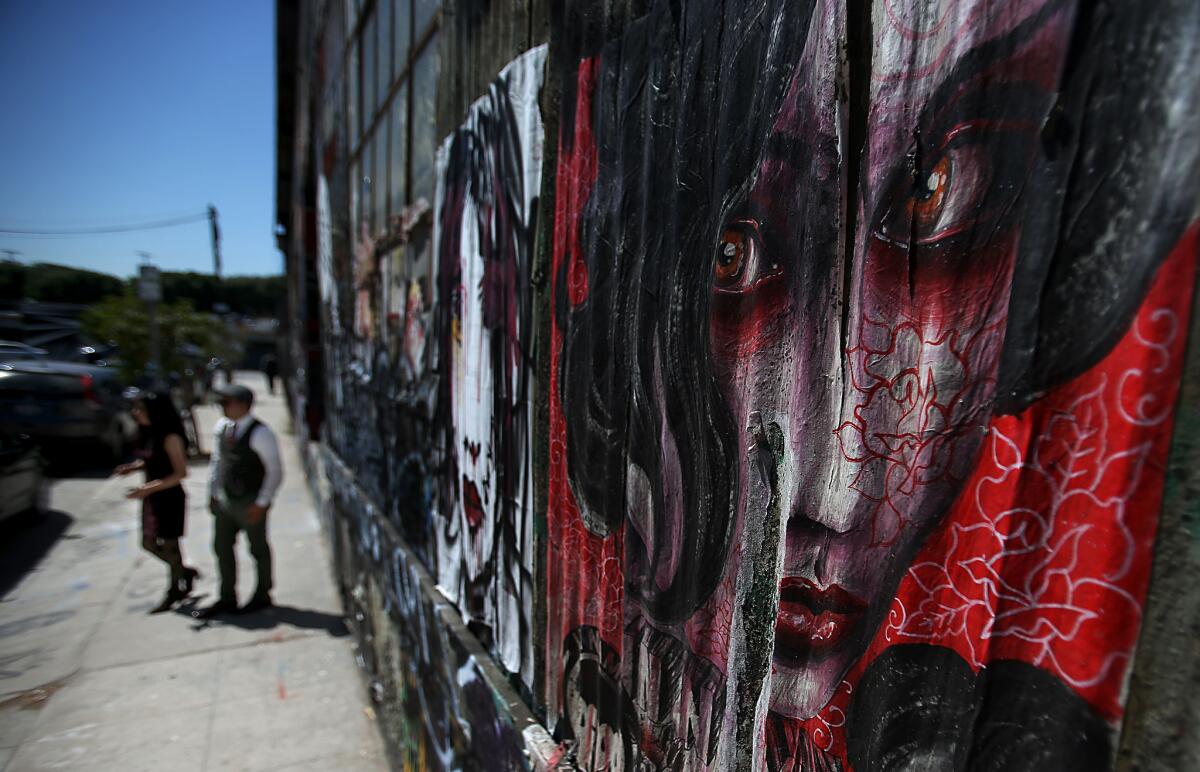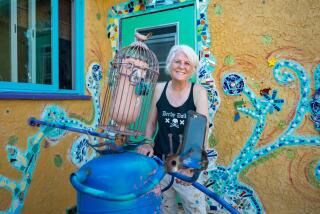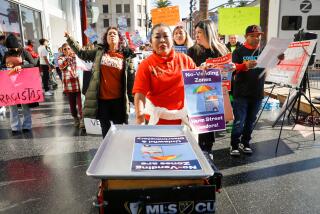Los Angeles moves to lift decade-old ban on public murals

Artists predicted a renaissance of public muraling across Los Angeles as the City Council voted 13-2 Wednesday to lift a decade-long ban on the large outdoor artworks.
“We owe it to our next generation to reclaim our legacy as a mural capital of the world,” said Isabel Rojas-Williams, executive director of the Mural Conservancy of Los Angeles.
The action represents a culmination of years of hearings on a new regulatory scheme for murals. It seeks a balance between clashing interests: reviving the city’s muralist tradition; protecting neighborhoods from unwanted intrusions of large, sometimes controversial artworks; and controlling a proliferation of advertising in the guise of art.
It was the latter objective that led to the ban a decade ago. Advertisers sued the city on 1st Amendment grounds because muralists could create big, eye-catching displays that were banned for commercial enterprises.
In the years since, weak and arbitrary application of the mural ban created inconsistencies and problems. Studio City Hand Car Wash owner Ben Forat received positive feedback -- and no real City Hall hassle -- when he put up a 75-foot-long painting on his business depicting the community’s landmarks.
Ditto for downtown artist Robert Vargas, who painted a stylized portrait of a mariachi on a bar in Boyle Heights, and young Pacoima muralist Levi Ponce’s efforts to fill his community’s walls with colorful works.
But when pop star Chris Brown put up eight-foot-high fanged creatures on a retaining wall at his Hollywood Hills home, neighbors deluged City Hall with complaints, the singer was cited and within weeks the cartoonish scene was obliterated.
The new rules, which must come back for an expected final approval next week, will permit new murals in business and industrial zones, as long as artists register them with the city and pay a $60 application fee. The works cannot contain a commercial message and must remain up for at least two years, as part of the city effort to control advertising.
Only residential areas that “opt in” to the mural program by petitioning the city would be permitted to have the artworks on walls and homes. Councilman Jose Huizar, who sponsored the law, favored a different version that would have required single-family neighborhoods to “opt out,” or allow murals everywhere -- including on single-family homes -- unless communities organize to ban them.
But that version failed to win support from representatives of suburban communities.
”It’s difficult to strike a balance,’’ said Councilman Mike Bonin, who represents Venice, Westchester and Pacific Palisades. “We’re a city of murals, but we’re first and foremost a city of neighborhoods.”
Councilmen Paul Koretz and Bob Blumenfield voted against the final measure, expressing concerns that neighborhoods that don’t want murals would not have enough of a voice in saying where they go.
Carlos Chavez was among many artists who told the council they are ready to paint. He recently moved to Los Angeles to do just that, Chavez said.
“I want to be part of the art scene here,’’ he said. “Let art flourish.”
ALSO:
Firefighters battle four-alarm blaze in Santa Ana industrial park
Containment of Yosemite fire now 23% as blaze climbs record books
Sister of alleged Hannah Anderson kidnapper: ‘There’s no evidence’
Twitter: @csaillant2 | Google+
catherine.saillant@latimes.com
More to Read
Sign up for Essential California
The most important California stories and recommendations in your inbox every morning.
You may occasionally receive promotional content from the Los Angeles Times.











